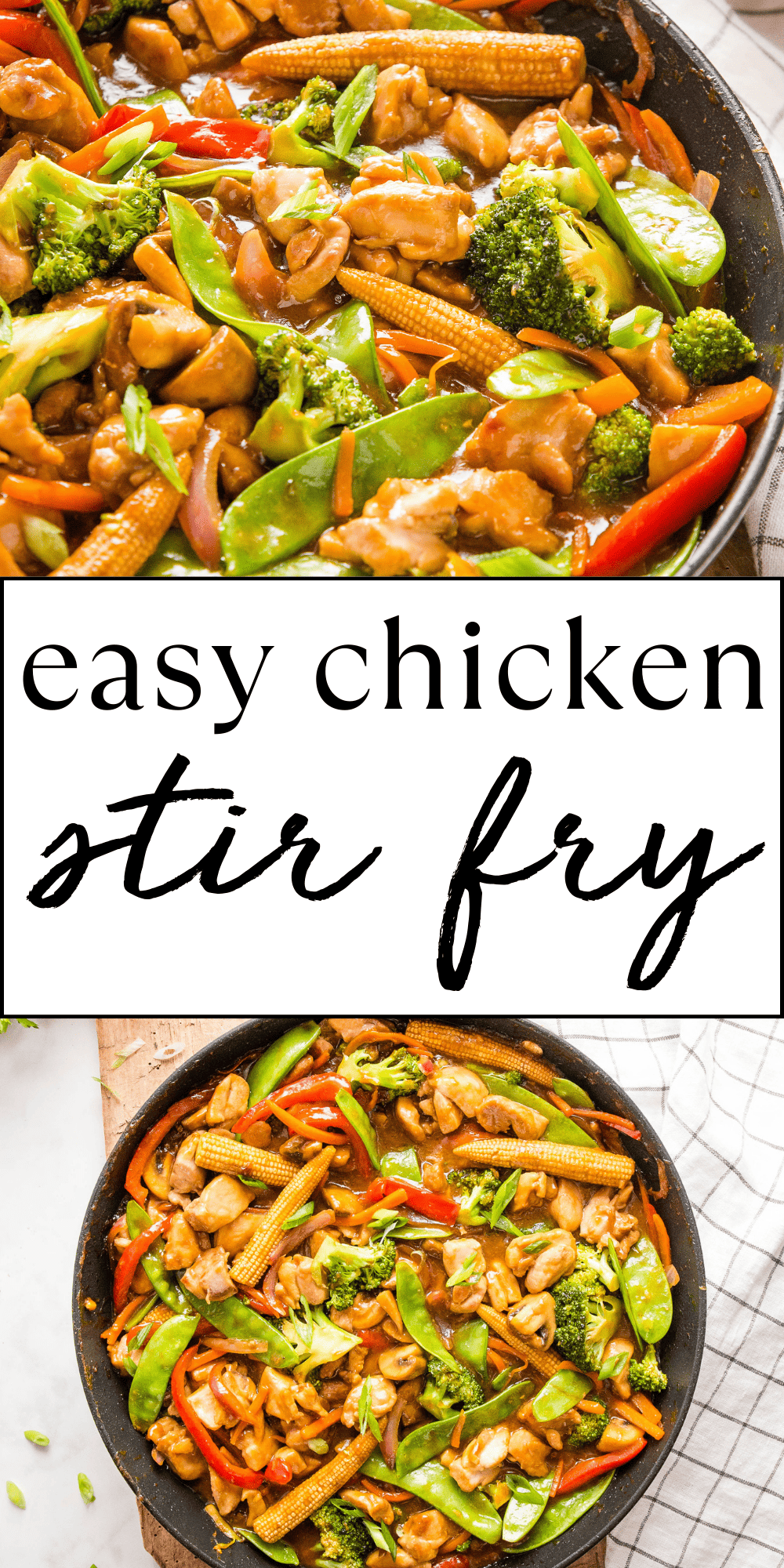This Chicken Stir Fry recipe is an easy weeknight meal that’s packed with protein and fresh vegetables – on the table in under 30 minutes. A simple chicken stir fry with an easy sauce and marinade – perfect for meal prep!
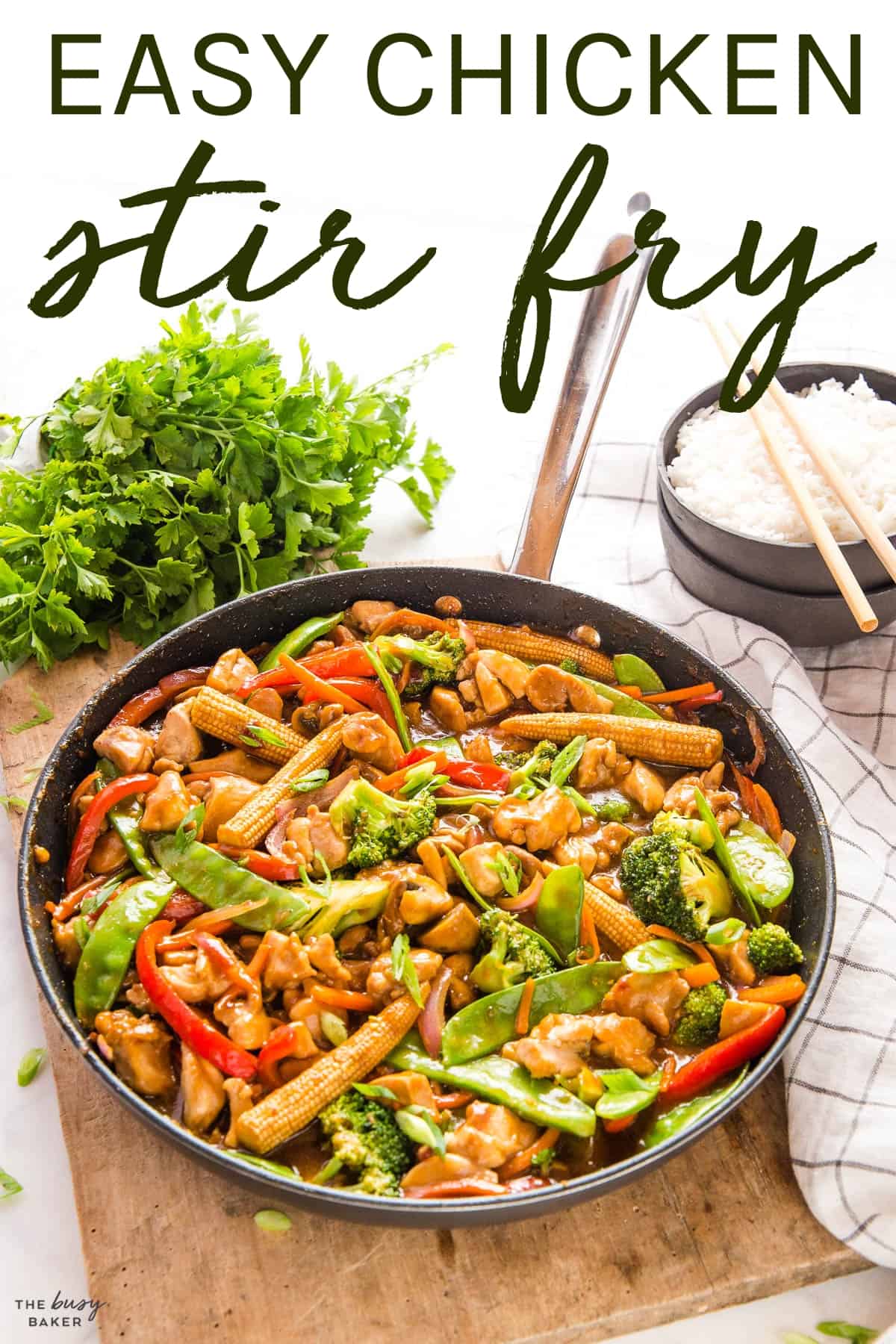
Estimated reading time: 14 minutes
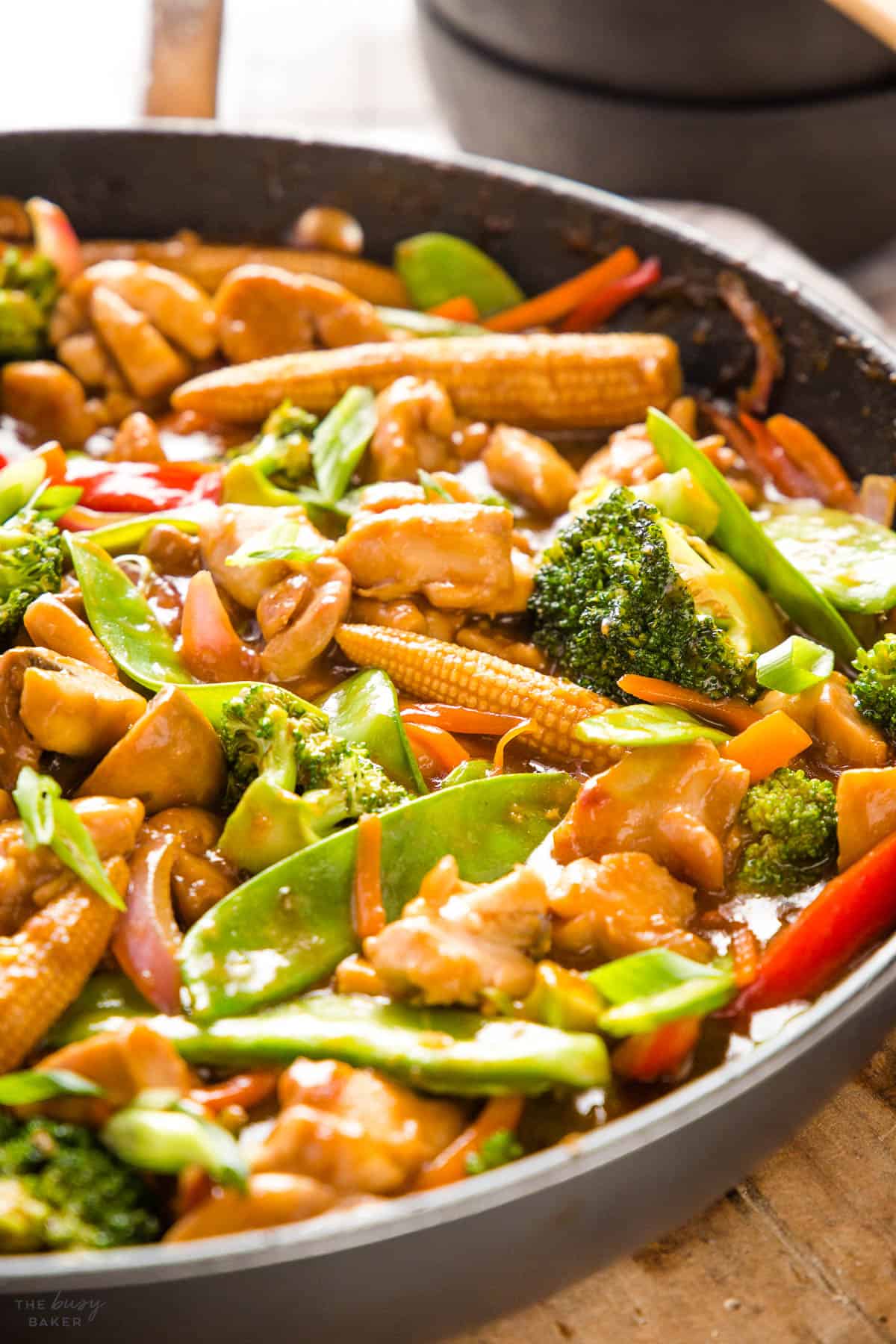
Here at The Busy Baker we’re always looking for new ways to get dinner on the table and this Chicken Stir Fry recipe is one of our family’s favourite easy meals to enjoy when life gets busy. What makes this Chicken Stir Fry recipe one to reach for? Glad you asked!
- We love a good dinner that comes together with minimal prep and effort, and this chicken stir fry takes just a little bit of chopping and measuring, keeping dinner prep to a minimum.
- When it comes to keeping prep time to a minimum, this recipe is a great one for adding pre-washed and pre-chopped veggies from the produce section of the grocery store if you want to save even MORE time and effort. We’ve even used a bag of frozen mixed veggies in this recipe before and while the result isn’t quite as amazing as if we’d used fresh veggies, it was still delicious and saved SO much time!
- Meals that are easy to customize to your family’s tastes, preferences, and even food allergies or intolerances are always a good idea, especially when you’re feeding kids or any picky eaters. Choose whatever veggies your family enjoys and serve it with white rice, brown rice, minute or instant rice, or even ramen or rice noodles – whatever you prefer!
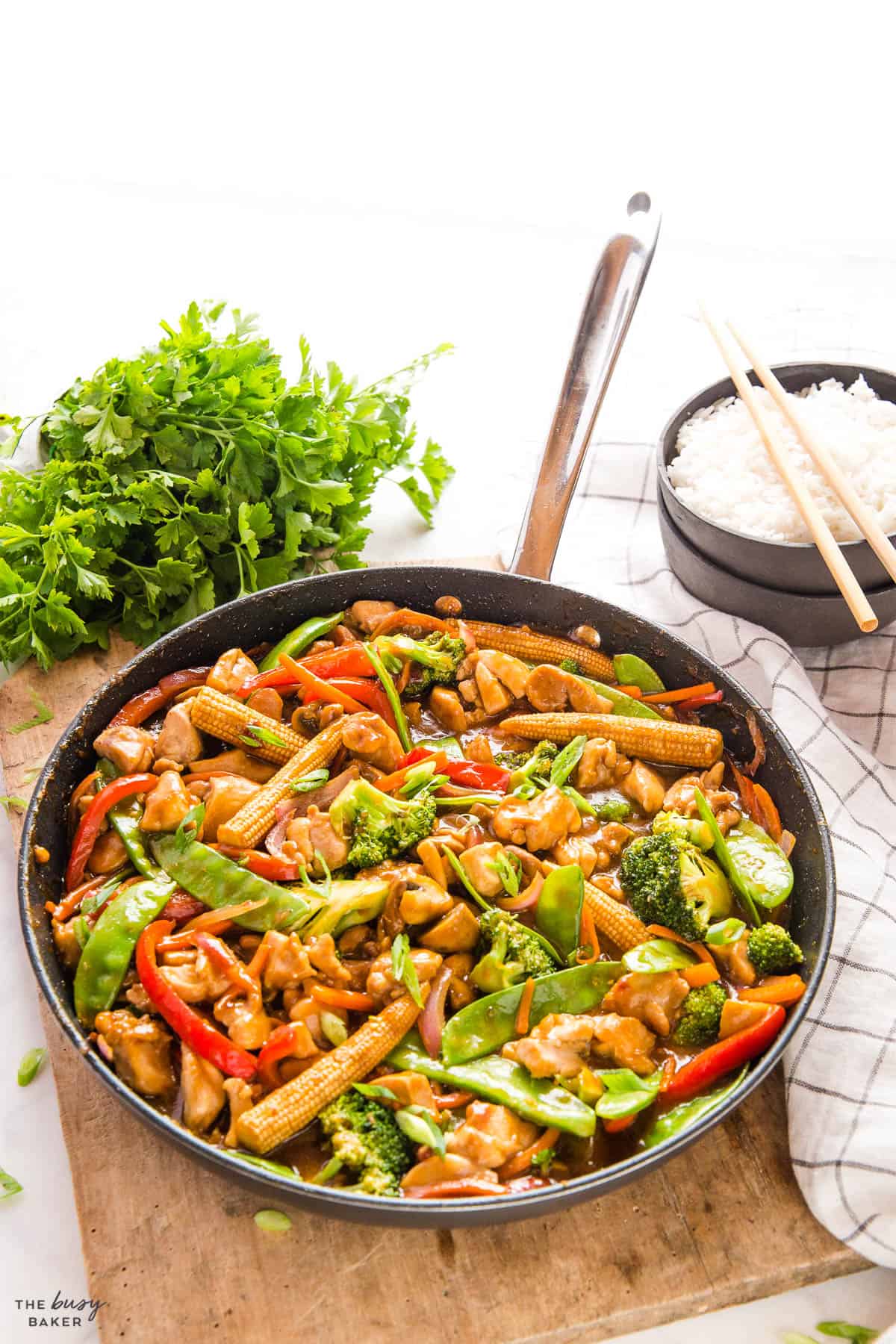
- When it comes to customization, meals that allow you to improvise depending on what ingredients you happen to have on hand are always a fantastic choice. This stir fry recipe works with any fresh veggies that stir fry well; think carrots, celery, broccoli, cauliflower, mushrooms, peppers, onions, snow peas, etc. Use what you have in the fridge and turn this stir fry into a fridge-clean-out recipe!
- Stir fry recipes require minimal kitchen equipment so if all you’ve got on hand are the basics, this is the recipe for you! Be sure to have some measuring cups and spoons, a chopping board and a knife for chopping, a good skillet or wok, and a cooking utensil like a wooden spoon or wooden turner.
- Meal prepping is one of our favourite ways to save time and this Chicken Stir Fry can be prepped in advance to save even MORE time! We love preparing the chicken ahead of time, chopping the veggies, and mixing the sauce ingredients and placing everything in (separate) airtight containers in the fridge until it’s time to cook. This helps keep the ingredients fresh and gives you a delicious result with minimal prep time during the week.
- Freezing your leftovers to reheat on days you REALLY don’t feel like cooking is a great way to keep your stress level low when life gets busy. This Chicken Stir Fry freezes well in an airtight container – just thaw it in the fridge overnight and reheat it in a skillet with a splash of water before serving it over rice!
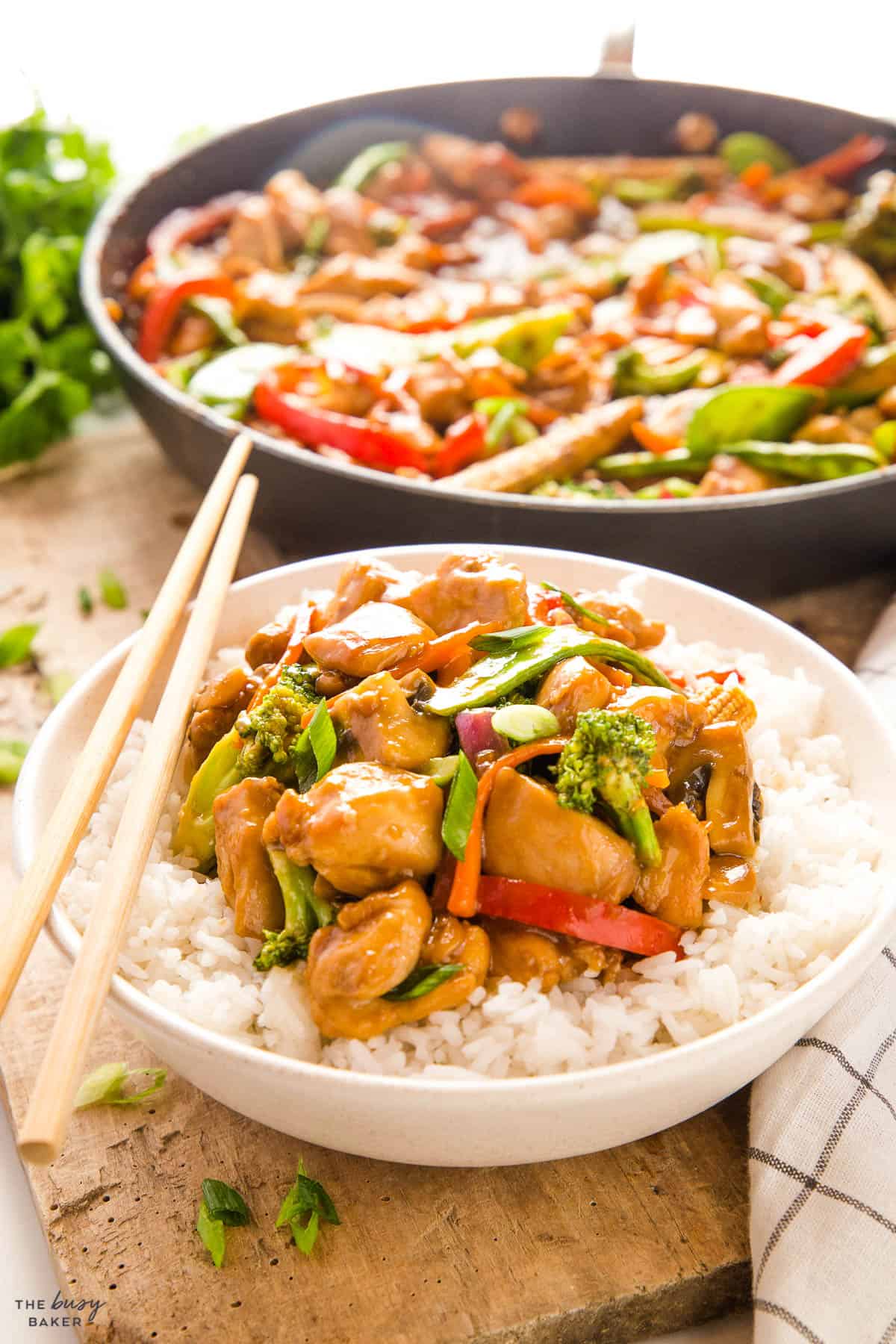
Stir fry is a common term used to describe a method of cooking that’s traditionally Chinese. It involves shallow-frying ingredients quickly in a small amount of hot oil while stirring continuously in a wok or deep skillet. Because it uses high heat and only a small amount of oil, stir frying creates a crisp texture and allows the food to keep its nutritional value by avoiding over-cooking. Stir frying combines multiple ingredients and therefore multiple flavours in a single dish.
Stir frying requires movement – constantly stirring the ingredients to expose them to the high heat evenly. Typically, ingredients are added in order of their cooking times with the longest cooking ingredients added first and the shortest cooking ingredients added last.
A sauce is often added to the ingredients once they’re almost cooked through to bring everything together. Stir fry can be served on its own, over steamed rice or noodles, or the noodles can be thrown into the pan with the sauce and for a truly one-pan meal.
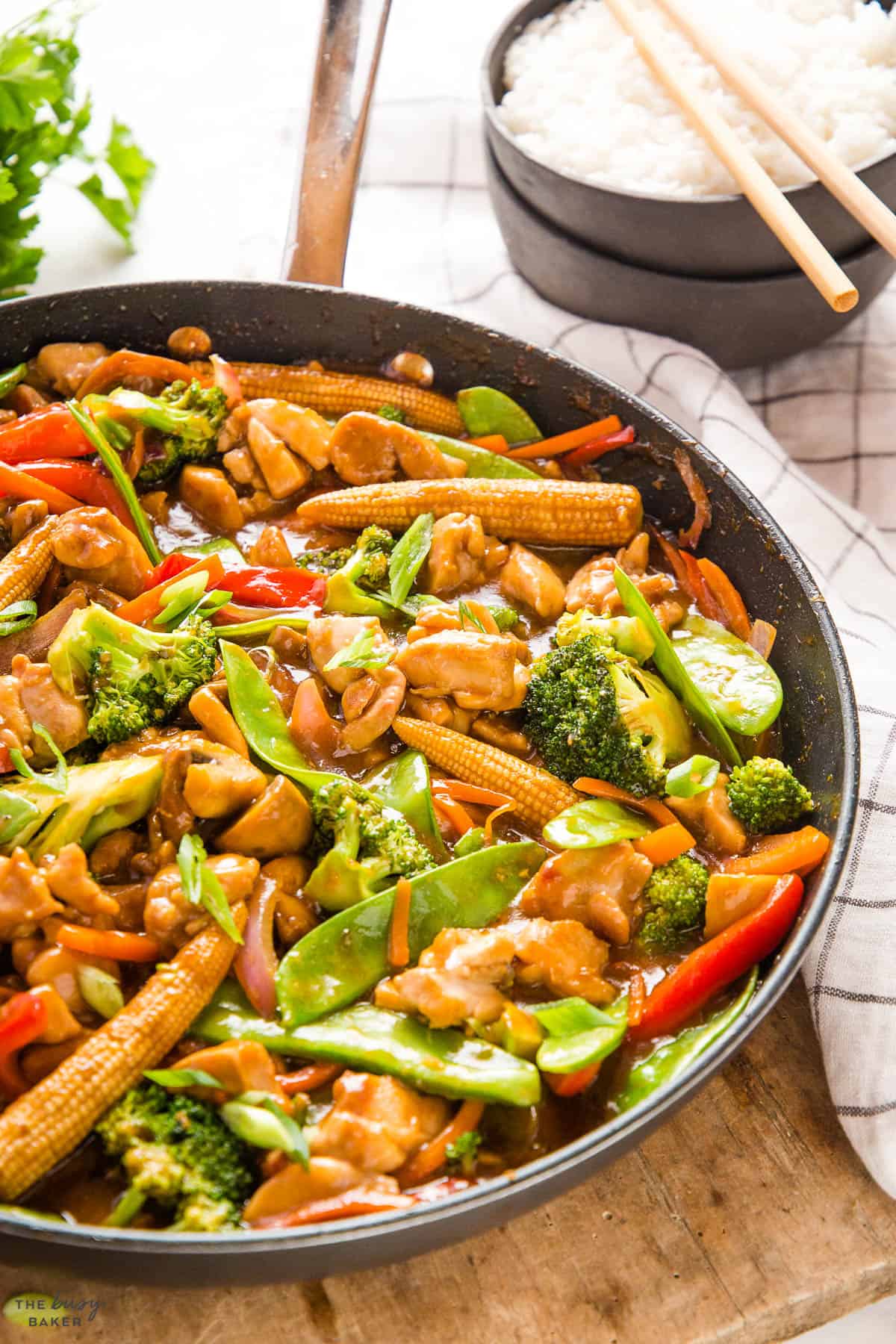
Making your own stir fry sauce is the key to a delicious and healthy homemade stir fry. Buying conventional sauces from the grocery store may save some time, but they’re packed with sugar and preservatives. Here’s the best and simplest way to make your own stir fry sauce that’s easy to make with basic grocery store ingredients and tastes absolutely delicious!
- Aim for a balance of salty, sweet, sour, and umami flavours. Using ingredients like soy sauce for saltiness (or gluten-free soy sauce if you’re gluten-free), rice vinegar for acidity, and hoisin sauce, oyster sauce or brown sugar or honey for sweetness creates a delicious flavour balance.
- Cornstarch is essential for thickening your sauce and giving it that glossy, clingy quality. It’s important to mix cornstarch with a cold liquid like water before adding it to your sauce to avoid lumps.
- For a tiny bit of heat, ingredients like Sriracha or chili flakes can be great additions to a stir fry sauce. We use the tiniest amount of Sriracha and it gives a lot of flavour with hardly any heat.
- Fresh aromatic ingredients like garlic and ginger add a burst of flavour to the sauce. It’s best to use fresh garlic and ginger and to grate or finely chop them to distribute their flavours throughout the sauce.
- Adding sesame oil as part of the sauce mellows its strong flavour that can sometimes be overpowering, and it adds a delicious Asian-style flavour to the sauce.
- Adjust the thickness by adding more or less water or cornstarch.
- Add the stir fry sauce towards the end of cooking. This allows the flavours to combine and the sauce to thicken without overcooking the meat and the vegetables.
Marinating the chicken in a chicken stir fry marinade is not a required step, but it’s a step that makes a big flavour and texture difference. We use the process of “velveting” which means creating a chicken stir fry marinade out of soy sauce, vinegar and cornstarch. Soaking the chicken in this marinade, even for a few minutes (although overnight creates a GREAT result!) creates the perfect texture on the outside of the chicken pieces as they cook.
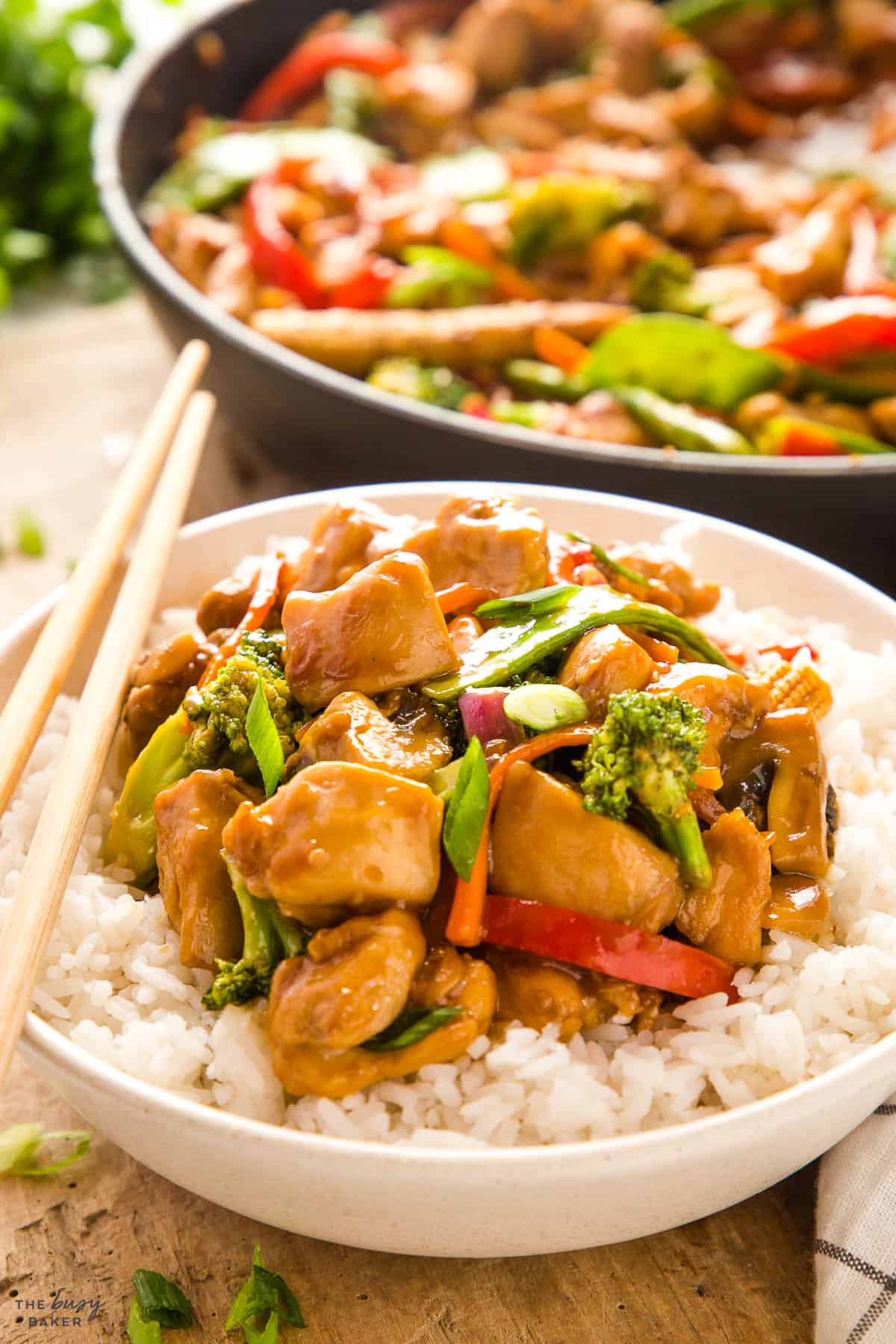
There’s nothing worse than cooking a delicious stir fry and having to let it sit while your rice cooks. Be sure to cook the rice first so it’s hot and ready to go.
It’s crucial to have all ingredients prepped and ready before you start cooking. Stir frying is a fast process and there’s no time for chopping or mincing once you’ve started cooking. Chop all your veggies and prepare the meat and sauce before you turn on the heat.
Chopping your veggies and meat to the right size, into small, even pieces helps ensure they cook quickly and evenly. Chop the fast-cooking veggies like peppers in larger pieces and slower cooking veggies like carrots in smaller, thinner pieces. This will help the veggies cook evenly.
When preparing a stir fry, it’s important to use a wok or a similar pan that can handle high heat and has ample space for tossing the ingredients.
Oils with a high smoke point, like grapeseed, canola, or vegetable oil, are recommended for stir frying. Sesame oil is a great choice for flavour, but we recommend adding it to the stir fry sauce for flavour instead of using it to cook the meat and veggies.
Marinate and then cook the meat first, before the veggies. This will allow you to cook the meat in batches (avoid overcrowding the pan!) and just until it’s cooked through to the correct internal temperature.
Aromatic ingredients like garlic, onion, and ginger are delicious ingredients that add a TON of flavour. Be sure to use fresh garlic and fresh ginger if you can!
Stir frying requires that you cook over high heat and keep the ingredients moving in the pan. The veggies should begin to caramelize on the outside and be slightly tender but not soft. The veggies should retain much of their bright colour.
Mix the sauce ingredients together in a bowl and be sure to add the cornstarch to thicken the sauce while the sauce is cold (before adding it to the hot pan). The sauce will thicken in the pan as it cooks and it will coat the meat and the veggies, creating a delicious and saucy stir fry.
Be sure to add the sauce only after the other ingredients are almost finished cooking. Turn the heat down, add the sauce and let it thicken and cook for just a couple minutes. The other ingredients won’t overcook and you’ll be left with the perfect sauce.
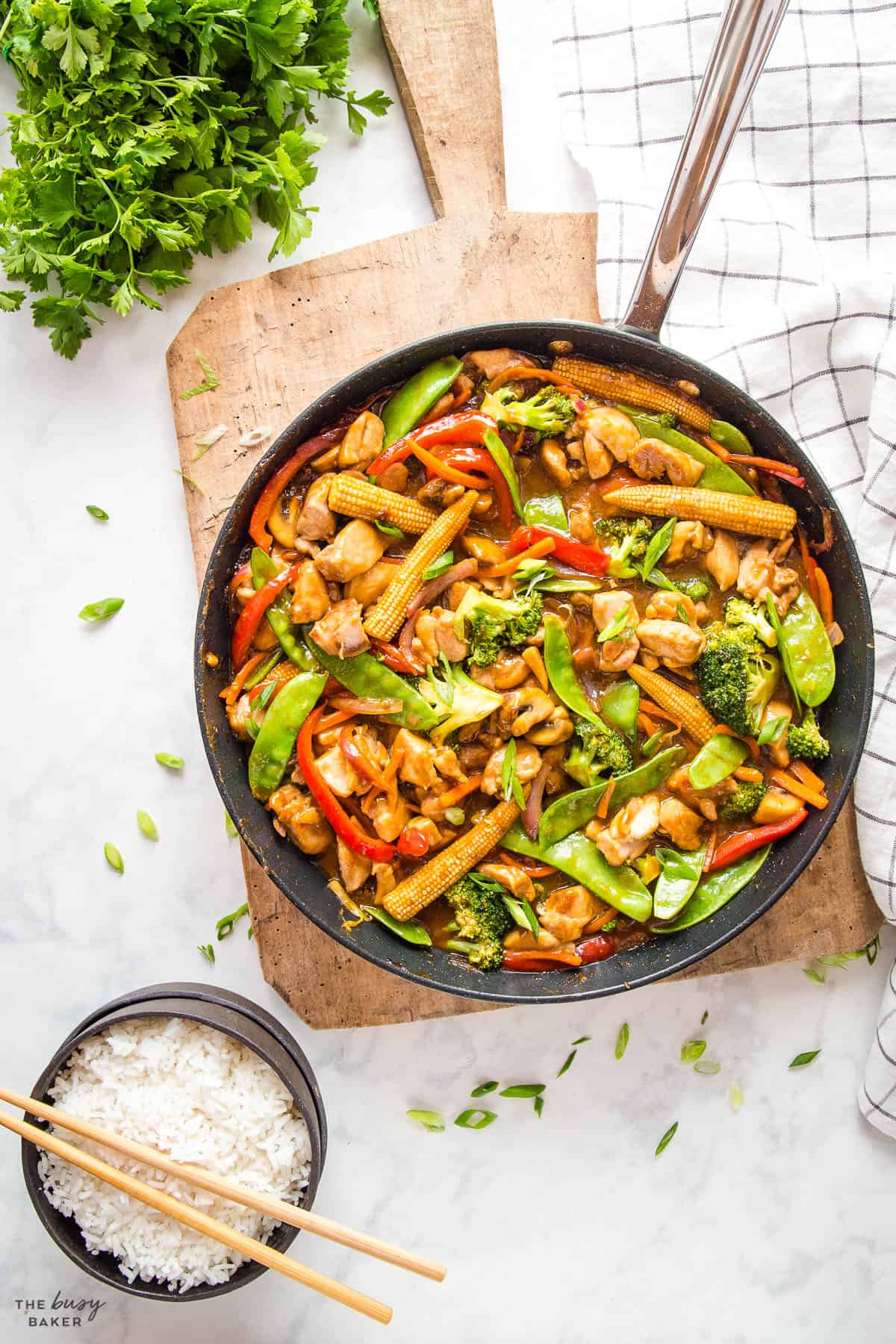
Making stir fry requires only basic kitchen equipment. Here’s what you’ll need to have on hand to make this recipe (paid links):
- a large skillet or wok
- a good, sharp chef’s knife
- a large Cutting Board for chopping the veggies
- measuring cups and spoons
- wooden cooking utensil
- mixing bowls for prepping ingredients
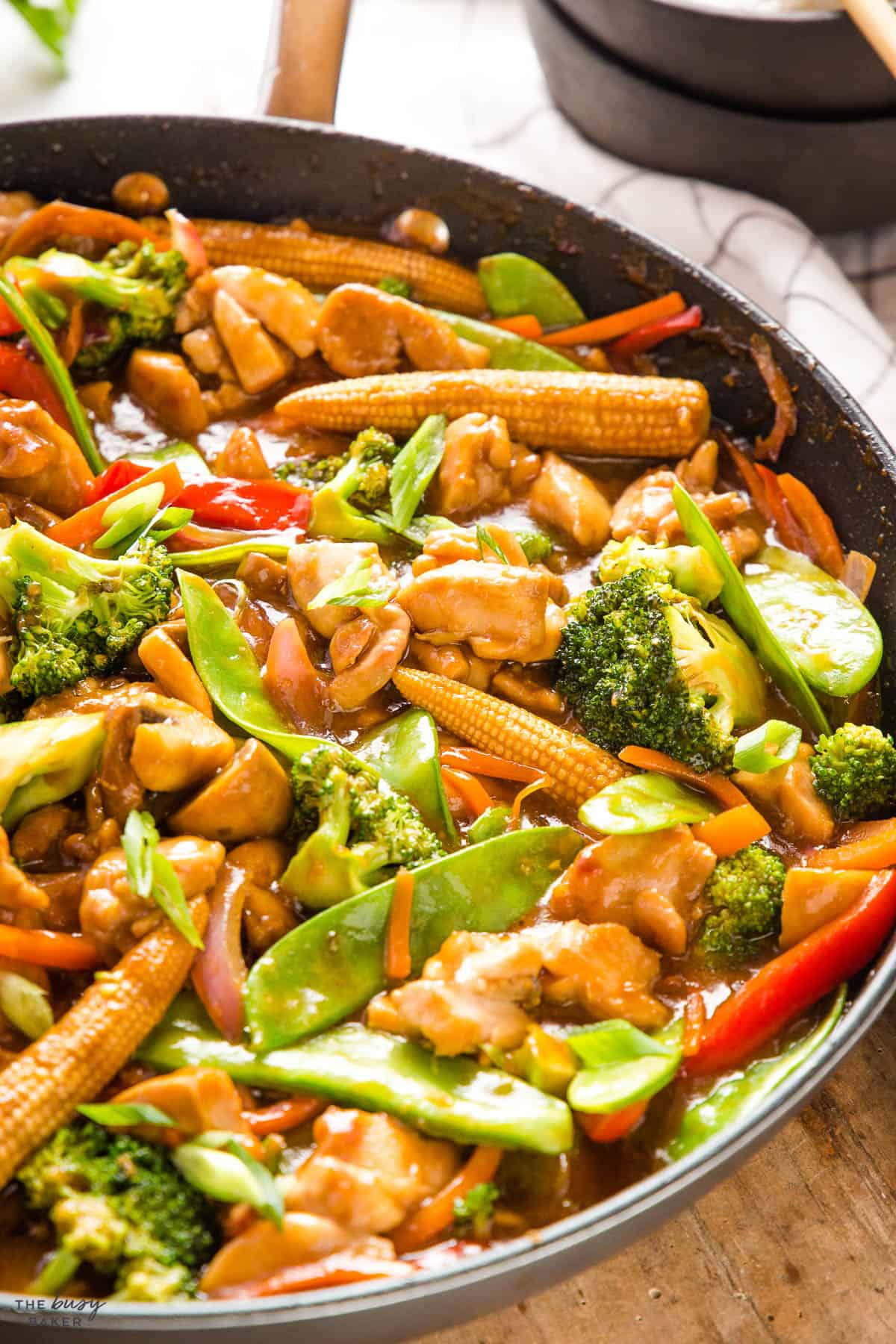
To make this stir fry chicken recipe, you’ll need these ingredients (paid links):
- 1 pound chicken breast
- 1 tablespoon olive oil
- 2 tablespoons soy sauce
- 2 tablespoons cornstarch
- 1 tablespoon rice vinegar
- 1 tablespoon olive oil
- 1 large red bell pepper cut in thin slices
- 1 cup snow peas
- 2 carrots Julienned or very thinly sliced
- 2 cups mushrooms cut in half
- 2 cups broccoli florets in bite-sized pieces
- 1/2 cup baby corn
- 1 large red onion sliced in thin wedges
- 2/3 cup soy sauce
- 3 tablespoons rice vinegar
- 2 tablespoons brown sugar or 3-4 tablespoons honey
- 2 tablespoons hoisin sauce optional
- 1-3 teaspoons Sriracha optional, but a little bit of heat is recommended for flavour
- 3 tablespoons sesame oil
- 5 cloves garlic
- 2 tablespoons ginger or 1.5 inch knob of ginger, grated. To substitute powdered ginger for fresh, use 1 1/2 teaspoons of powdered ginger.
- 4 tablespoons cornstarch
- 8 tablespoons water
- rice, rice noodles, or other noodles (your choice)
- chopped green onions for garnish (optional)
- sesame seeds for garnish (optional)
- chopped peanuts for garnish (optional)
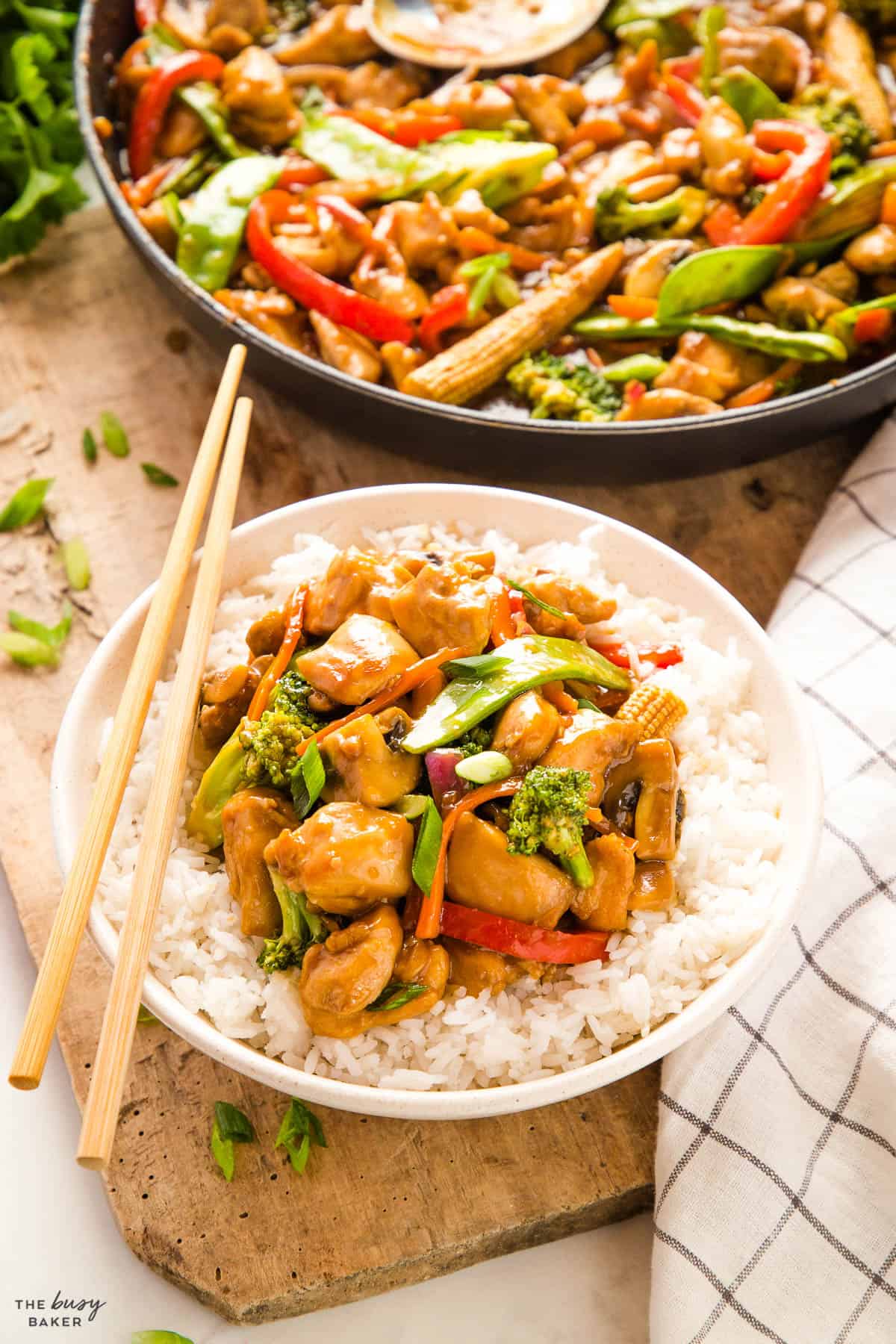
Looking to switch things up? Try one of these delicious variations on the classic Chicken Stir Fry recipe:
- Tofu – Replace the chicken with seasoned tofu for a vegetarian option.
- Cabbage – Add several handfuls of shredded cabbage instead of serving over rice for a lower-carb option.
- Beef – Substitute the chicken for lean beef for a delicious beef stir fry.
- Chicken thighs – Use chicken thighs instead of chicken breasts for an even more flavourful stir fry with tender chicken.
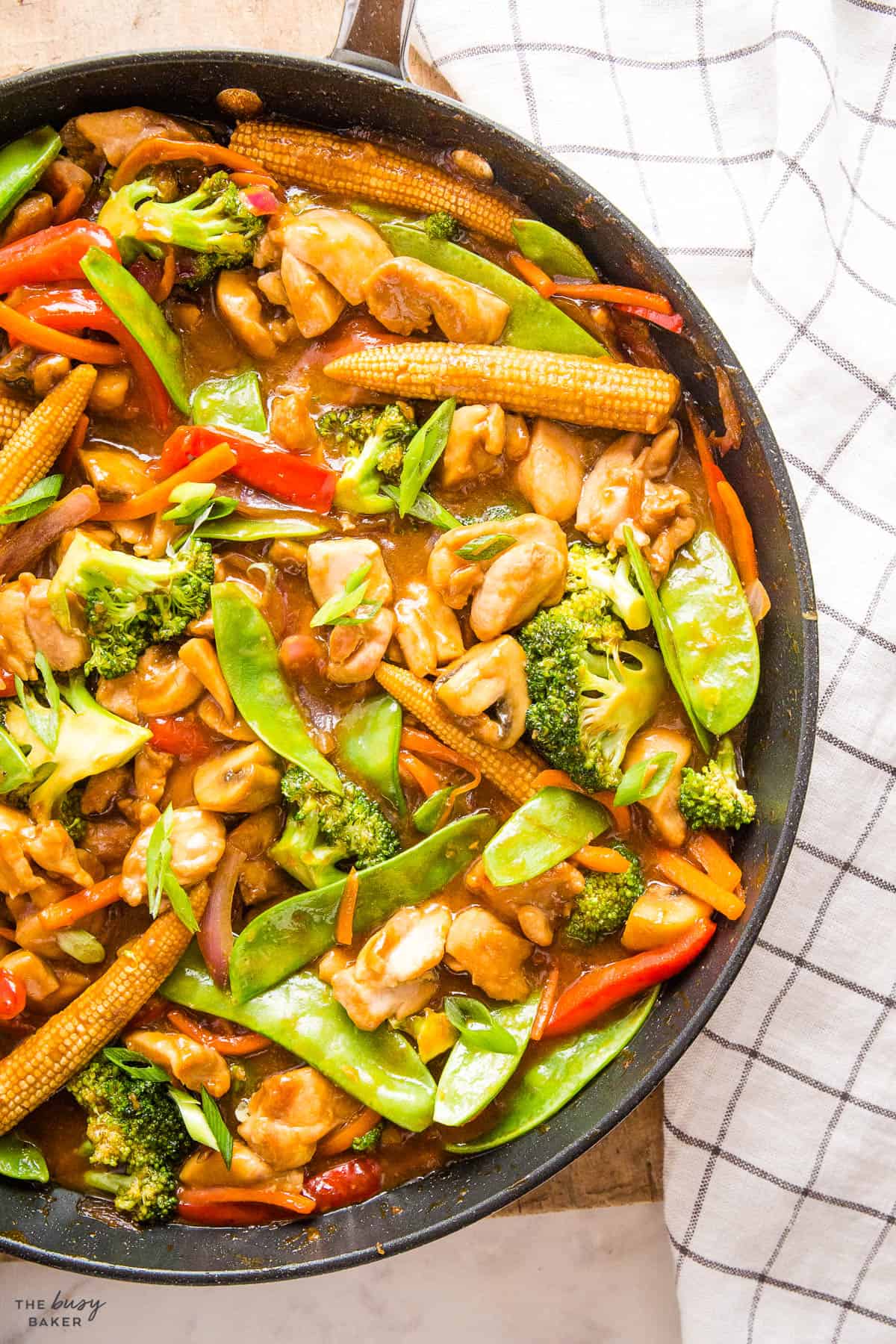
Time needed: 25 minutes
Follow these simple steps to make the perfect stir fry.
- Prepare all your ingredients.
Chop all the veggies, get the chicken marinating in the marinade, and mix your sauce ingredients together in a bowl.
- Cook the rice.
Start cooking the rice before you begin cooking the stir fry. The rice may take longer to cook than the stir fry and it’s best to serve the stir fry right after it finishes cooking.
- Use high heat.
Use high heat and a deep skillet for the best results. This will keep the chicken and veggies tender without over-cooking.
- Cook the chicken first.
Stir fry the chicken first and once it’s cooked through, remove it to a plate and set it aside. You may need to cook the chicken in batches depending on the size of your pan (avoid overcrowding the pan).
- Stir fry the veggies next.
Stir fry the veggies after the chicken and stir fry them just until tender. They should still retain their bright colours and not be too soft.
- Add the sauce last.
Add the chicken back into the pan with the veggies and then add the sauce. Cook the sauce just until thickened and until it coats the chicken and veggies nicely, then serve the stir fry over rice.

Should you boil chicken before stir frying?
In some traditional recipes the chicken is boiled before stir frying, but it’s not necessary to boil the chicken first.
What gets cooked first in a stir fry?
Be sure to stir fry the meat first, remove it from the pan, and then stir fry the veggies. Add the meat back into the hot pan, reduce the heat, then add the sauce and cook just until it’s thickened.
Why is stir fry chicken so tender?
It’s because of a process called “velveting” which calls for the chicken to soak in a mixture of soy sauce, vinegar and cornstarch. This marinade softens the chicken and makes it extra tender.
Why is my chicken stir fry rubbery?
Stir fry chicken turns rubbery when it’s been cooked over low heat for too long. Be sure to use high heat and cook it only until cooked through.
Why is my chicken stir fry dry?
Overcooking the chicken will cause it to become dry. Be sure to cook the chicken only until it’s cooked through and don’t forget to add the sauce to be sure the stir fry stays nice and moist.
Why is my stir fry soggy?
Soggy stir fry can happen when the vegetables are overcooked and release too much moisture. Be sure to cook the vegetables only until tender. They should still be bright in colour.
Can I make stir fry ahead of time?
Yes, although stir fry is best served fresh. To make this recipe ahead of time we suggest preparing all the components and storing them in the fridge in separate containers. When it’s time to eat simply cook the prepared chicken, veggies and sauce according to the recipe directions.
Can I freeze stir fry?
This stir fry can be frozen, although it is best enjoyed fresh. To freeze it, add it to an airtight container and freeze for up to 3 months.
How to reheat stir fry?
Reheat this stir fry in a skillet on the stove with a splash of water. Be sure not to over-cook during the reheating process. Reheat just until heated through.
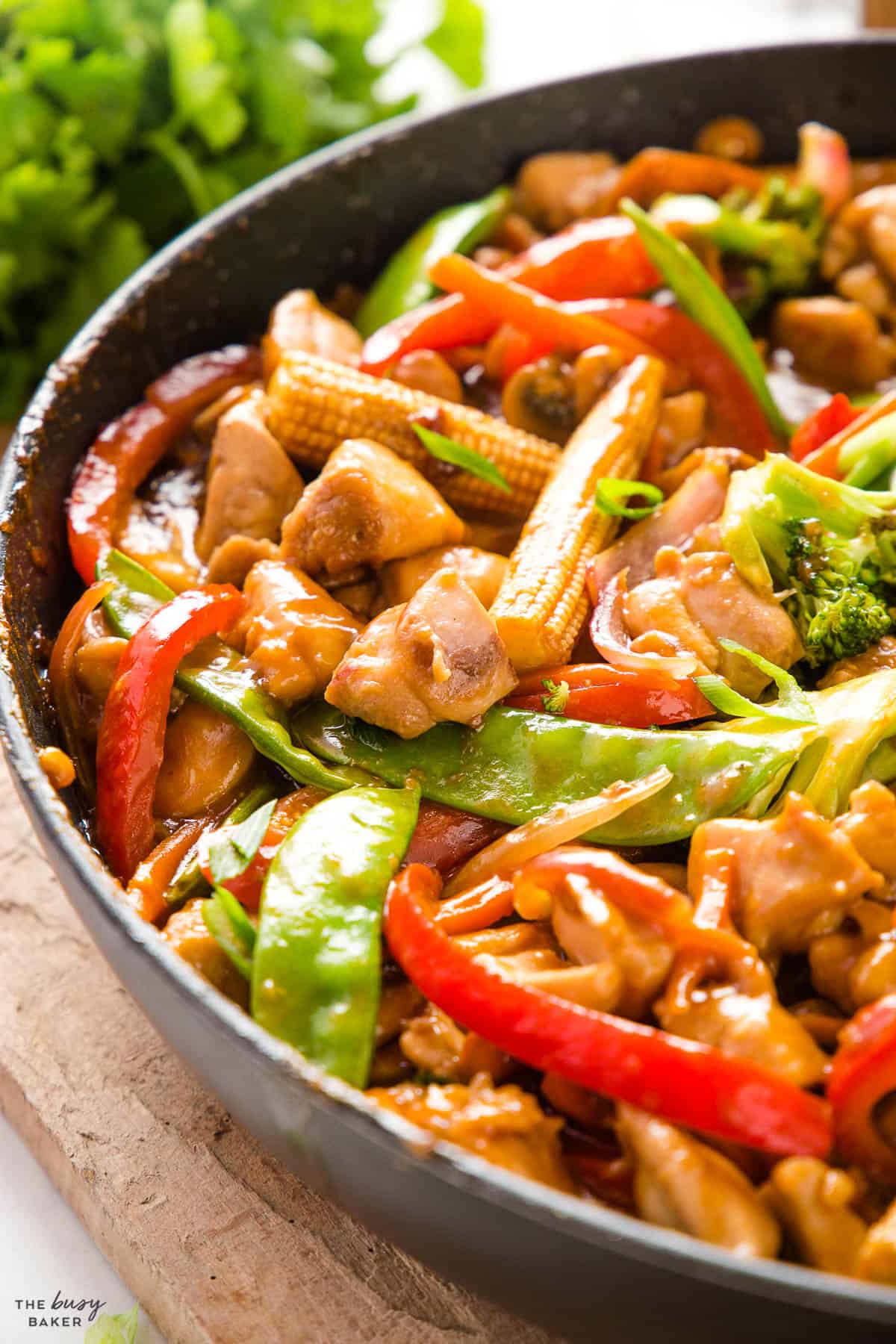
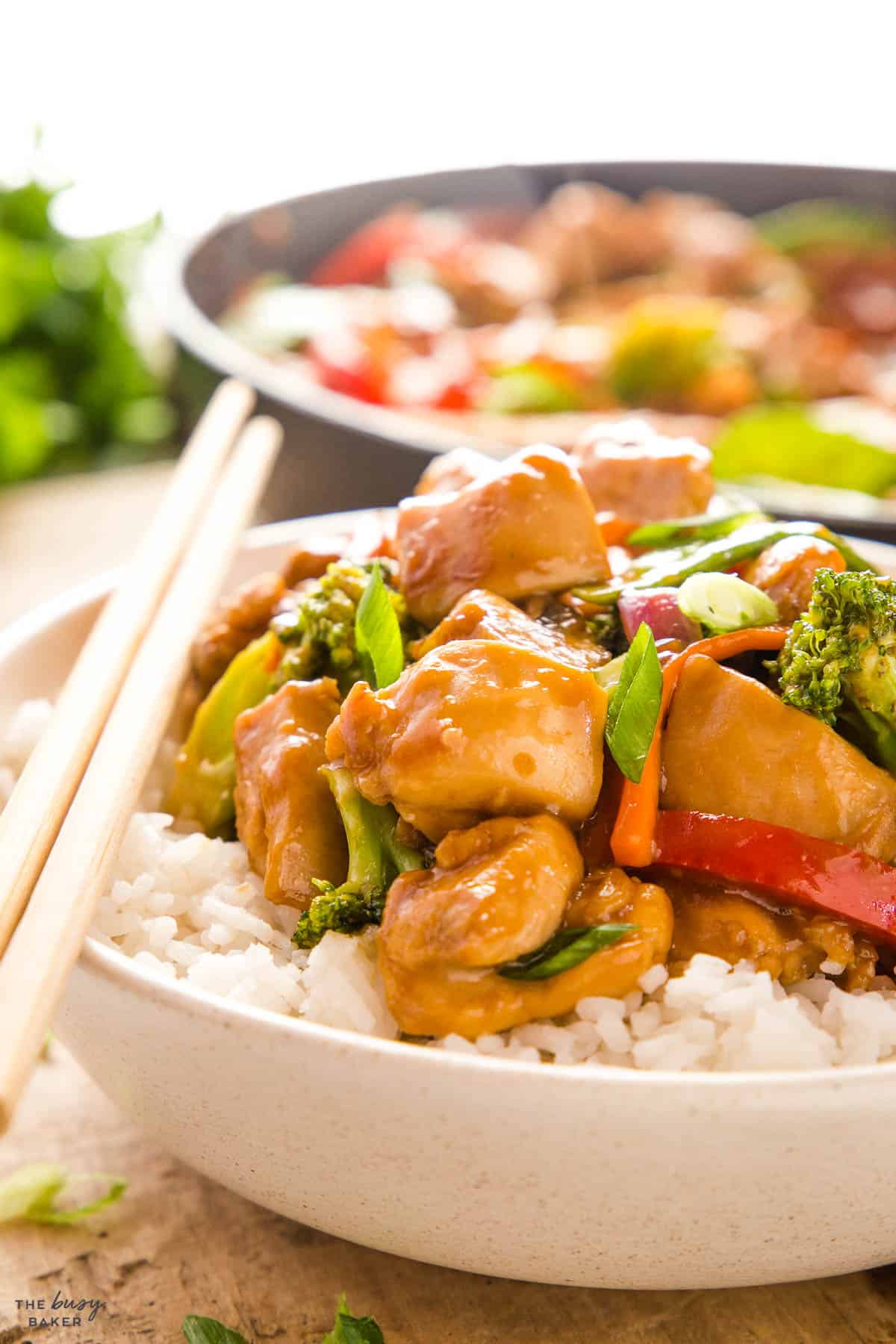
We hope you love this recipe as much as we do! Let us know in the comments below, what’s your favourite easy weeknight meal? We’d love to know!
Watch the video below to see exactly how we make this recipe. You can find many more deliciously simple recipe videos on our YouTube channel!
If you made this, share a photo!
Are you trying this recipe? Use the comment form below to share your take; now with support for image uploads and comment voting!
Chicken Stir Fry
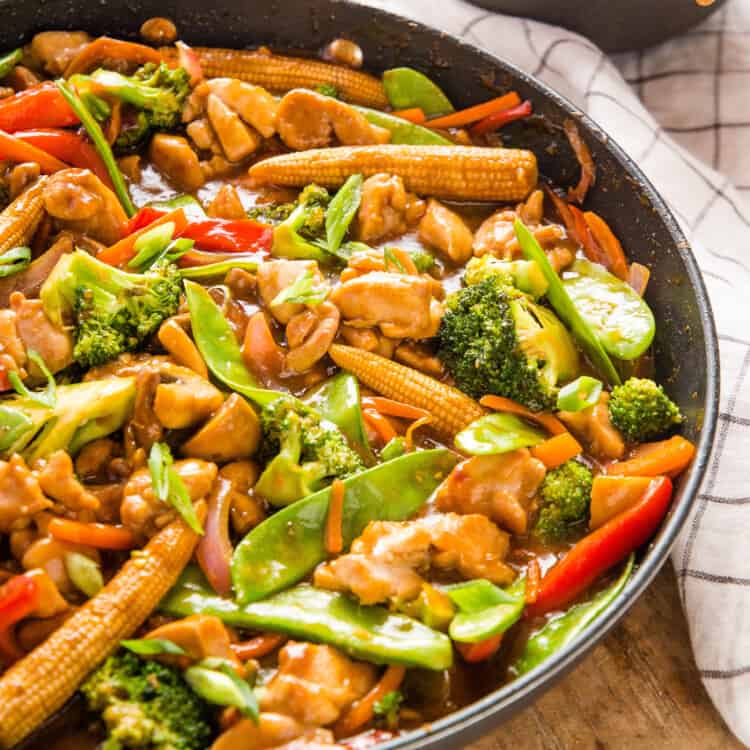
Recipe: Equipment
Recipe: Ingredients
- 1 pound chicken breast
- 1 tablespoon olive oil
For the Chicken
- 2 tablespoon soy sauce
- 2 tablespoon cornstarch
- 1 tablespoon rice vinegar
For the vegetables
- 1 tablespoon olive oil
- 1 large red bell pepper cut in thin slices
- 1 cup snow peas
- 2 carrots Julienned or very thinly sliced
- 2 cups mushrooms cut in half
- 2 cups broccoli florets in bite-sized pieces
- 1/2 cup baby corn
- 1 large red onion sliced in thin wedges
For the stir fry sauce
- 2/3 cup soy sauce
- 3 tablespoons rice vinegar
- 2 tablespoons brown sugar or 3-4 tablespoons honey
- 2 tablespoons hoisin sauce optional
- 1-3 teaspoons Sriracha optional, but a little bit of heat is recommended for flavour
- 3 tablespoons sesame oil
- 5 cloves garlic
- 2 tablespoons ginger or 1.5 inch knob of ginger, grated. To substitute powdered ginger for fresh, use 1 1/2 teaspoons of powdered ginger.
- 4 tablespoons cornstarch
- 8 tablespoons water
Recipe: Instructions
- Cut the chicken into 1 inch cubes and add to a bowl. Over the chicken add soy sauce, rice vinegar and cornstarch. Mix well and set to the side.
- Wash and chop your veggies.
- Heat a large skillet or wok over medium-high heat and add the olive oil. When the oil is hot, add in the chicken so the bottom of the pan is covered but not overcrowded. You may have to cook it in two batches.
- When the chicken is browned on all sides and cooked through, remove it to a plate repeat with the remaining chicken.
- Measure out the sauce ingredients, mix them and set aside.
- Add 1 tablespoon of olive oil to the skillet or wok.
- Add the carrots, onions, mushrooms, peppers and baby corn and cook. As they're cooking, add the broccoli florets and snow peas to the skillet and sauté for just a few moments. Make sure the veggies are vibrant in colour and still have a bite to them.
- Add the chicken (with the juices on the plate) back in and mix. Add the sauce ingredients to the pan and mix them well until you get a nice, velvety sauce that thickens slightly.
- Serve over rice or noodles.
Recipe: Notes
Recipe Substitutions
For this chicken stir fry recipe you can use chicken tenders, chicken breast or even boneless skinless chicken thighs.Storage Instructions
This stir fry keeps well in an airtight container in the fridge for up to 3 days.Freezer Instructions
Although we don’t recommend freezing this stir fry after cooking (for best results), it is possible to freeze it in an airtight container for up to 3 months.Recipe: Nutrition
Notice: Nutrition is auto-calculated, using Spoonacular, for your convenience. Where relevant, we recommend using your own nutrition calculations.
